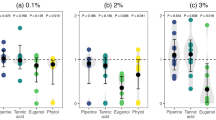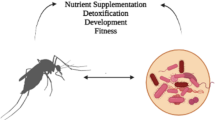Abstract—
Drosophila melanogaster fruit flies are an important model for studying the multifaceted interactions between a multicellular organism and its microbiome. The nature of these interactions is largely determined by the regular changes in abundance and composition of the microbiome that occur during the host’s life. The currently available data on age- and life cycle stage-related changes in the Drosophila microbiome relate mainly to its bacterial component, while little is known about such changes in the equally important yeast component. The present work describes the quantitative and qualitative composition of the yeast component of the D. melanogaster microbiome in three laboratory lines, reared under different conditions, at four developmental stages: late larvae and adults aged 1, 7, and 14 days after eclosion. In all three lines, the total yeast abundance changed similarly with the age of insects, with the highest and lowest yeast counts in 7- and 1-day adults, respectively. In the fly lines reared on moderately unfavorable substrates supplemented with 2 and 4% NaCl, the abundance and species diversity of yeasts at all four developmental stages was higher than in the flies reared on a standard (favorable) food substrate. Our results indicate the inconstancy of the yeast component of the D. melanogaster microbiome and its regular changes with the insect’s age, which must be taken into account when studying the relationships between symbiotic yeasts and their hosts.

Similar content being viewed by others
REFERENCES
Anagnostou, C., Dorsch, M., and Rohlfs, M., Influence of dietary yeasts on Drosophila melanogaster life-history traits, Entomol. Exp. Appl., 2010, vol. 136, pp. 1–11.
Becher, P.G., Flick, G., Rozpędowska, E., Schmidt, A., Hagman, A., Lebreton, S., Larsson, M.C., Hansson, B.S., Piškur, J., and Bengtsson, M., Yeast, not fruit volatiles mediate Drosophila melanogaster attraction, oviposition and development, Function. Ecol., 2012, vol. 26, pp. 822‒828.
Belkina, E.G., Naimark, E.B., Gorshkova, A.A., and Markov, A.V., Does adaptation to different diets result in assortative mating? Ambiguous results from experiments on Drosophila, J. Evolution Biol., 2018, vol. 31, pp. 1803–1814.
Bordenstein, S.R. and Theis, K.R., Host biology in light of the microbiota: ten principles of holobionts and hologenomes, PLoS Biol., 2015, vol. 13, e1002226.
Broderick, N.A. and Lemaitre, B., Gut-associated microbes of Drosophila melanogaster, Gut Microbes, 2012, vol. 3, pp. 307–321.
Brummel, T., Ching, A., Seroude, L., Simon, A.F., and Benzer, S., Drosophila lifespan enhancement by exogenous bacteria, Proc. Natl. Acad. Sci. U. S. A., 2004, vol. 101, pp. 12974–12979.
Chandler, J.A., Eisen, J.A., and Kopp, A., Yeast communities of diverse Drosophila species: comparison of two symbiont groups in the same hosts, Appl. Environ. Microbiol., 2012, vol. 78, pp. 7327–7336.
Chandler, J.A., Lang, J.M., Bhatnagar, S., Eisen, J.A., and Kopp, A., Bacterial communities of diverse Drosophila species: ecological context of a host–microbe model system, PLoS Genet., 2011, vol. 7, p. e1002272.
Choińska, R., Piasecka-Jóźwiak, K., Chabłowska, B., Dumka, J., and Łukaszewicz, A., Biocontrol ability and volatile organic compounds production as a putative mode of action of yeast strains isolated from organic grapes and rye grains, Antonie van Leeuwenhoek, 2020, vol. 113, pp. 1135–1146.
Clark, R.I., Salazar, A., Yamada, R., Fitz-Gibbon, S., Morselli, M., Alcaraz, J., Rana, A., Rera, M., Pellegrini, M., Ja, W.W., and Walker, D.W., Distinct shifts in microbiota composition during Drosophila aging impair intestinal function and drive mortality, Cell Reports, 2015, vol. 12, pp. 1656–1667.
Coluccio, A.E., Rodriguez, R.K., Kernan, M.J., and Neiman, A.M., The yeast spore wall enables spores to survive passage through the digestive tract of Drosophila, PLoS One, 2008, vol. 3, e2873.
Dmitrieva, A.S., Ivnitsky, S.B., and Markov, A.V., Adaptation of Drosophila melanogaster to unfavorable feed substrate is accompanied by expansion of trophic niche, Biology Bull. Rev., 2017, vol. 7, pp. 369–379.
Dmitrieva, A.S., Ivnitsky, S.B., Maksimova, I.A., Panchenko, P.L., Kachalkin, A.V., and Markov, A.V., Symbiotic yeasts affect adaptation of Drosophila melanogaster to food substrate with high NaCl concentration, PLoS One, 2019, vol. 14. e0224811.
Douglas, A.E., The Drosophila model for microbiome research, Lab. Animal., 2018, vol. 47, pp. 157–164.
Erkosar, B. and Leulier, F., Transient adult microbiota, gut homeostasis and longevity: novel insights from the Drosophila model, FEBS Lett., 2014, vol. 588, pp. 4250–4257.
Erkosar, B., Storelli, G., Defaye, A., and Leulier, F., Host-intestinal microbiota mutualism: “learning on the fly,” Cell Host Microbe., 2013, vol. 13, pp. 8–14.
Glushakova, A.M. and Kachalkin, A.V., Endophytic yeasts in Malus domestica and Pyrus communis fruits under anthropogenic impact, Microbiology (Moscow), 2017, vol. 86, pp. 128‒135.
Guilhot, R., Rombaut, A., Xuéreb, A., Howell, K., and Fellous, S., Bacterial influence on the maintenance of symbiotic yeast through Drosophila metamorphosis, bioRxiv, preprint posted June 1, 2020. https://doi.org/10.1101/2020.05.31.126185
Günther, C.S. and Goddard, M.R., Do yeasts and Drosophila interact just by chance?, Fungal Ecol., 2019, vol. 38, pp. 37‒43.
Hoang, D., Kopp, A., and Chandler, J.A., Interactions between Drosophila and its natural yeast symbionts—Is Saccharomyces cerevisiae a good model for studying the fly‒yeast relationship?, Peer J., 2015, vol. 3, e1116.
Ivnitsky, S.B., Maximova, I.A., Panchenko, P.L., Dmitrieva, A.S., Kachalkin, A.V., Kornilova, M.B., Perfilieva, K.S., and Markov, A.V., Microbiome affects the adaptation of Drosophila melanogaster to a high NaCl concentration, Biology Bull. Rev., 2019, vol. 9, pp. 465–474.
The Yeasts, A Taxonomic Study, Kurtzman, C.P., Fell, J.W. and Boekhout, T., Eds., Elsevier, 2011, 5th ed.
Margulis, L. and Fester, R., Symbiosis as a Source of Evolutionary Innovation: Speciation and Morphogenesis, Boston: MIT, 1991.
Markov, A.V. and Ivnitsky, S.B., Evolutionary role of phenotypic plasticity, Mos. Univ. Biol. Sci. Bull., 2016, vol. 71. № 4, pp. 185–192.
Markov, A.V., Ivnitsky, S.B., Kornilova, M.B., Naimark, E.B., Shirokova, N.G., and Perfilieva, K.S., Maternal effect obscures adaptation to adverse environments and hinders divergence in Drosophila melanogaster, Biology Bull. Rev., 2016, vol. 6, pp. 429–435.
McFall-Ngai, M.J., Unseen forces: the influence of bacteria on animal development, Dev. Biol., 2002, vol. 242, pp. 1–14.
Moran, N.A. and Sloan, D.B., The hologenome concept: helpful or hollow?, PLoS Biol., 2015, vol. 13, e1002311.
Newell, P.D., Chaston, J.M., Wang, Y., Winans, N.J., Sannino, D.R., Wong, A.C.-N., Dobson, A.J., Kagle, J., and Douglas, A.E., In vivo function and comparative genomic analyses of the Drosophila gut microbiota identify candidate symbiosis factors, Front. Microbiol., 2014, vol. 4, p. 576.
Nicholson, J.K., Holmes, E., Kinross, J., Burcelin, R., Gibson, G., Jia, W., and Pettersson, S., Host-gut microbiota metabolic interactions, Science, 2012, vol. 336, pp. 1262–1267.
Panchenko, P.L., Kornilova, M.B., Perfilieva, K.S., and Markov, A.V., Contribution of symbiotic microbiota to adaptation of Drosophila melanogaster to an unfavorable growth medium, Biol. Bull., 2017, vol. 44, pp. 345–354. https://doi.org/10.1134/s1062359017040100
Reuter, M., Bell, G., and Greig, D., Increased outbreeding in yeast in response to dispersal by an insect vector, Curr. Biol., 2007, vol. 17, pp. R81–R83.
Rosenberg, E., Koren, O., Reshef, L., Efrony, R., and Zilber-Rosenberg, I., The role of microorganisms in coral health, disease and evolution, Nat. Rev. Microbiol., 2007, vol. 5, pp. 355–362.
Rosenberg, E., Sharon, G., and Zilber-Rosenberg, I., The hologenome theory of evolution contains Lamarckian aspects within a Darwinian framework, Environ. Microbiol., 2009, vol. 11, pp. 2959–2962.
Savinov, A.B., Autocenosis and democenosis as symbiotic systems and biological categories, Zh. Obshch. Biol., 2012, vol. 73, pp. 284‒301.
Shin, S.C., Kim, S.H., You, H., Kim, B., Kim, A.C., Lee, K.A., Yoon, J.H., Ryu, J.H., and Lee, W.J., Drosophila microbiota modulates host developmental and metabolic homeostasis via insulin signaling, Science, 2011, vol. 334, pp. 670–674.
Stamps, J.A., Yang, L.H., Morales, V.M., and Boundy-Mills, K.L., Drosophila regulate yeast density and increase yeast community similarity in a natural substrate, PLoS One, 2012, vol. 7, p. e42238.
Starmer, W.T., A comparison of Drosophila habitats according to the physiological attributes of the associated yeast communities, Evolution, 1981, vol. 35, pp. 38–52.
Staubach, F., Baines, J.F., Künzel, S., Bik, E.M., and Petrov, D.A., Host species and environmental effects on bacterial communities associated with Drosophila in the laboratory and in the natural environment, PLoS One, 2013, vol. 8, e70749.
Téfit, M.A., Gillet, B., Joncour, P., Hughes, S., and Leulier, F., Stable association of a Drosophila-derived microbiota with its animal partner and the nutritional environment throughout a fly population’s life cycle, J. Insect Physiol., 2018, vol. 106, pp. 2‒12.
Trinder, M., Daisley, B.A., Dube, J.S., and Reid, G., Drosophila melanogaster as a high-throughput model for host–microbiota interactions, Front. Microbiol., 2017, vol. 8, article 751.
Tryselius, Y., Samakovlis, C., Kimbrell, D.A., and Hultmark, D., CecC, a cecropin gene expressed during metamorphosis in Drosophila pupae, Eur. J. Biochem., 1992, vol. 204, pp. 395–399.
Wong, C.N.A., Ng, P., and Douglas, A.E., Low-diversity bacterial community in the gut of the fruitfly Drosophila melanogaster, Environ. Microbiol., 2011, vol. 13, pp. 1889–1900.
Wong, C.N.A., Vanhove, A.S., and Watnick, P.I., The interplay between intestinal bacteria and host metabolism in health and disease: lessons from Drosophila melanogaster, Dis. Model. Mech., 2016, vol. 9, pp. 271–281.
Yamada, R., Deshpande, S.A., Bruce, K.D., Mak, E.M., and Ja, W.W., Microbes promote amino acid harvest to rescue undernutrition in Drosophila, Cell Rep., 2015, vol. 10, pp. 865–872.
Zilber-Rosenberg, I. and Rosenberg, E., Role of microorganisms in the evolution of animals and plants: the hologenome theory of evolution, FEMS Microbiol. Rev., 2008, vol. 32, pp. 723–735. Translated by P. Sigalevich
Funding
The work was supported by the Russian Foundation for Basic Research, projects nos. 19-34-90141 and 18-04-00915).
Author information
Authors and Affiliations
Corresponding author
Ethics declarations
The authors declare that they have no conflict of interest. All applicable international, national, and/or institutional guidelines for the care and use of animals were followed.
Rights and permissions
About this article
Cite this article
Dmitrieva, A.S., Maksimova, I.A., Kachalkin, A.V. et al. Age-Related Changes in the Yeast Component of the Drosophila melanogaster Microbiome. Microbiology 90, 229–236 (2021). https://doi.org/10.1134/S0026261721020028
Received:
Revised:
Accepted:
Published:
Issue Date:
DOI: https://doi.org/10.1134/S0026261721020028




